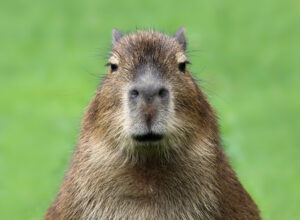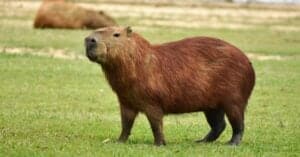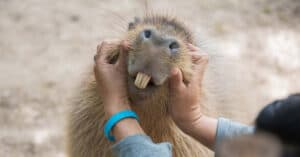Upon first glance, you may not notice too many differences between a capybara vs nutria. However, there are many different traits and characteristics that separate these two aquatic rodents, whether it looks like it or not. But what might some of these differences be, and how can you learn how to tell these two extremely similar animals apart?
In this article, we will address all of the differences between capybaras and nutrias, including their preferred habitats, diets, and socialization. We will also go over their physical appearances so that you can learn their differences at first glance. Let’s get started and talk about these two unique creatures now!
Comparing Capybara vs Nutria

| Capybara | Nutria | |
| Size | 60-150 pounds; 40-50 inches | 10-20 pounds; 15-25 inches long |
| Appearance | No tail, tan fur; head, ears, and eyes on top of their head. Stocky appearance with short muzzle | Long rat-like tail, dark brown fur; white muzzle and orange teeth. Similar in appearance to a rat or beaver |
| Location and Habitat | South America; found in many habitats so long as they are near water. | Worldwide; lives in burrows alongside riverbanks or marshes. Considered an invasive species |
| Behavior | Lives in very social herds; doesn’t sleep very much. Extremely active swimmer | Vocal in their socializations; often breeds throughout the year. Builds platforms out of plants to rest on top of the water |
| Diet | Bark, grass, aquatic plants | Rhizomes, plant stems |
Key Differences Between Capybara vs Nutria

Nutrias are much smaller than capybaras overall, often only a quarter of their size.
©sunsinger/Shutterstock.com
There are many key differences between capybaras and nutrias. Capybaras are members of the Caviidae family, while nutrias are members of the Myocastoridae family. Nutrias are much smaller than capybaras overall, often only a quarter of their size. The social behaviors of the capybara differ greatly from the nutria as well.
Let’s talk about all of these differences in greater detail now.
Capybara vs Nutria: Size and Weight

A nutria only reaches 10-20 pounds on average, while capybaras weigh over 100 pounds!
©Ondrej Prosicky/Shutterstock.com
The primary difference between a capybara vs nutria is their size and weight. Capybaras far outweigh nutrias, and they are much larger than nutrias as well. The average capybara is 40-50 inches long, while the average nutria is 15-25 inches long. You can easily tell the difference between these two creatures if you look at them side by side.
A nutria only reaches 10-20 pounds on average, while capybaras weigh over 100 pounds! This size difference is immense, but it is especially important when you consider where capybaras and nutrias are found in the wild. Let’s talk more about their locations and preferred habitats now.
Capybara vs Nutria: Location and Habitat Preferences
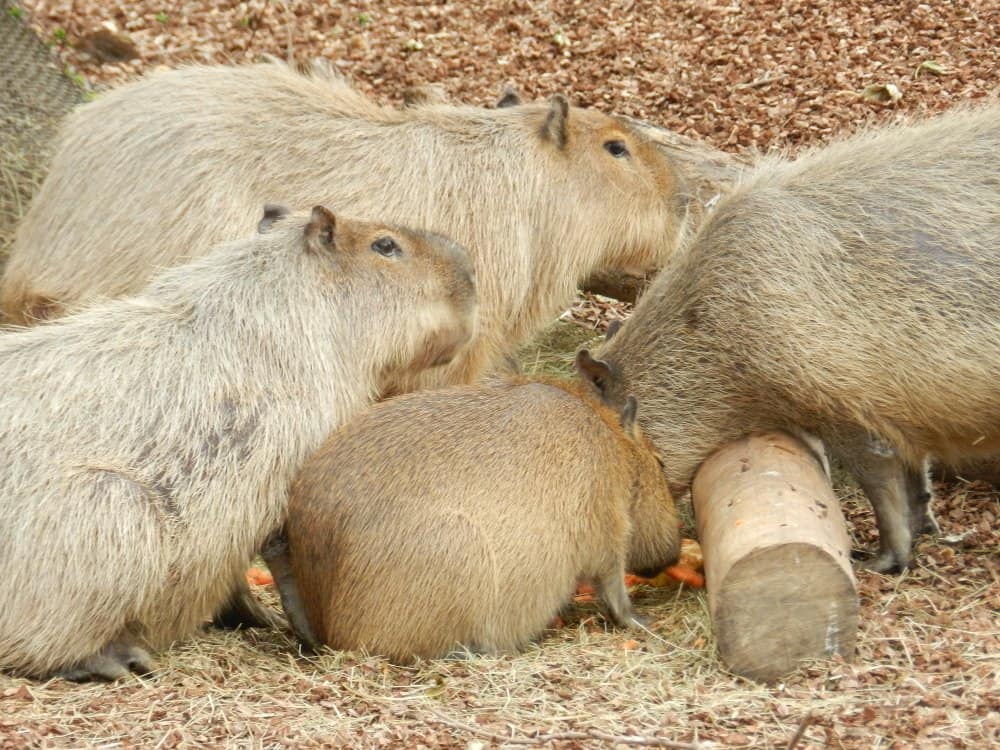
Capybaras live in grassy or marshy regions with water close by at all times, while nutrias create complicated burrows along riverbanks or ponds.
©Millie Bond – Copyright A-Z Animals
While both the capybara and the nutria originated in South America, only nutria are located worldwide nowadays. This is because nutrias are considered an invasive species, while capybaras are not. However, both of these creatures enjoy living in and amongst water, but there are some differences in their habitats.
Capybaras live in grassy or marshy regions with water close by at all times, while nutrias create complicated burrows along riverbanks or ponds. Nutrias also build rafts or platforms that they use to navigate rivers and streams, while capybaras enjoy swimming using their powerful bodies.
Capybara vs Nutria: Appearance

The main physical difference between these two is that nutrias have extremely long and rat-like tails, while capybaras do not have a tail at all.
©Barbora Polivkova/Shutterstock.com
While both the capybara and the nutria have similar coats to one another, you can easily tell the difference between these two animals based on their physical appearances. Capybaras have tan fur, while nutrias have dark brown fur. The main physical difference between these two is that nutrias have extremely long and rat-like tails, while capybaras do not have a tail at all.
Speaking of rats, nutrias look similar to beavers or rats, while capybaras have a stocky and very unique body shape. Capybaras are also special because their ears, eyes, and nostrils all lie on top of their heads. This gives them access to all of their senses while they swim, while nutrias have a face that is more similar to that of a beaver.
You can also distinguish a nutria from a capybara by looking at its muzzle. Nutrias have white on their muzzles, as well as brown and orange teeth that often peek out. Capybaras do not often show their teeth, and they are one solid color throughout.
Capybara vs Nutria: Behavior
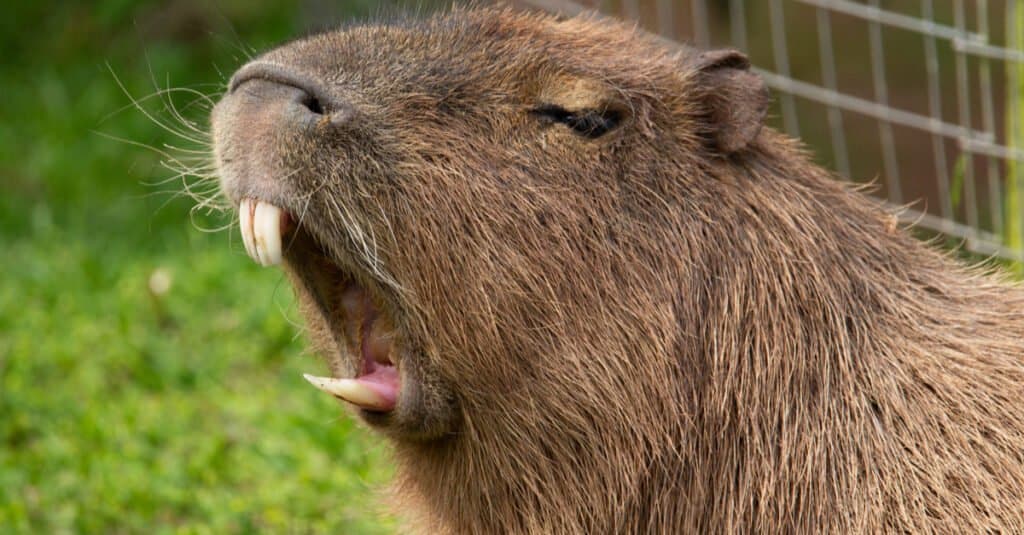
Capybaras don’t sleep very much, which is different from the primarily nocturnal nutria.
©Ian Peter Morton/Shutterstock.com
Both capybaras and nutrias are very social creatures among their own kind. Capybaras enjoy living in large herds, especially in grassy areas. The same can be said for nutrias as well, though the herd size of capybaras is often larger. However, both of these creatures communicate with their own kind using a series of unique sounds and grunts.
Capybaras don’t sleep very much, which is different from the primarily nocturnal nutria. They are active at night, while capybaras prefer to doze in the sun whenever they can, with no set schedule. Nutrias also dig complicated burrows and tunnels, while capybaras do not.
Capybara vs Nutria: Diet
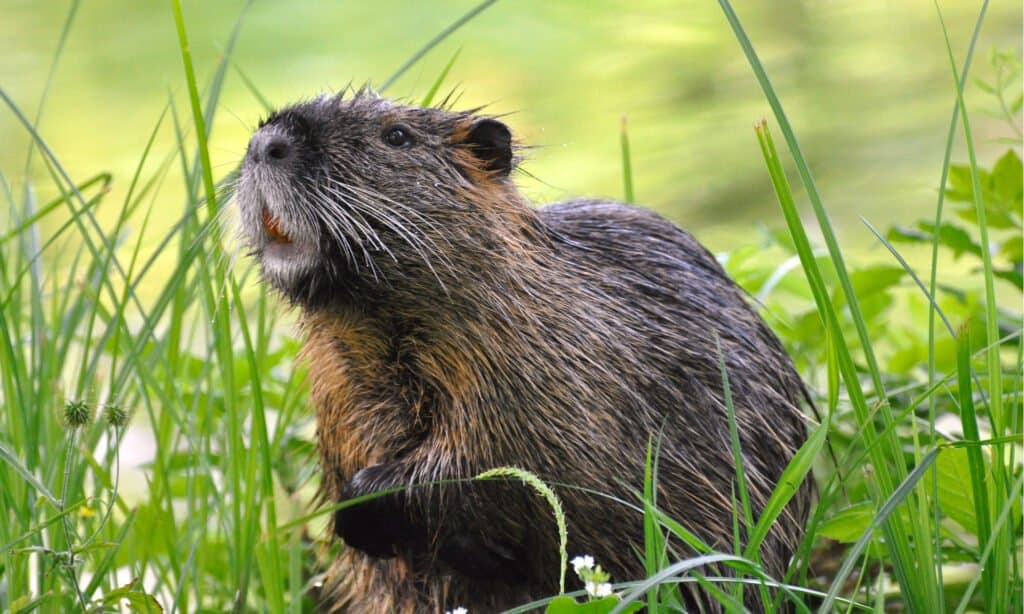
While both of these creatures are herbivores, capybaras eat bark, grass, and aquatic plants, while nutrias eat the entirety of many land-dwelling plants.
©Sonja Guijarro/Shutterstock.com
A final difference between capybaras and nutrias is their diet. While both of these creatures are herbivores, capybaras eat bark, grass, and aquatic plants, while nutrias eat the entirety of many land-dwelling plants. This leads to nutrias often getting a bad rap compared to capybaras. Let’s talk more about what this means.
Since nutrias eat entire plants, including the root or rhizome, they are capable of decimating ecosystems. Nutrias are notorious for consuming whole fields or populations of plants and leaving nothing behind for other animals. They also don’t leave behind any seeds so that the plant can regrow, thus devastating certain areas or habitats.
The photo featured at the top of this post is © Barbora Polivkova/Shutterstock.com
Thank you for reading! Have some feedback for us? Contact the AZ Animals editorial team.



